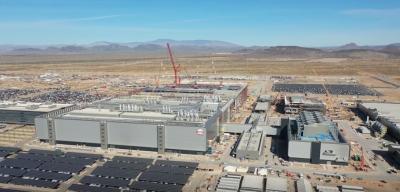As in many urban areas, infrastructure in King County, Wash., was not built to handle the needs of today’s population levels; in 2006, King County was the nation’s 14th largest county, with 1.8 million people.
Even a decade ago, it was clear that the area’s growing population would soon overwhelm its two existing sewage treatment plants in Seattle and Renton. In fact, the possibility of a development moratorium was raised due to wastewater management concerns.
King County needed to make improvements — and soon. Residents and officials from the communities near the Seattle and Renton sewage plants protested the expansion of those facilities, so the search began to find a site to accommodate a new plant. In 2003, after studying 95 potential areas, King County chose a location for the Brightwater treatment plant.
The Snohomish County site is a 114-acre (46 ha) parcel north of the city of Woodinville, past the intersection of state Route 9 and state Route 522. In addition to the new wastewater treatment plant and odor prevention system, plans for the site include the restoration of 40 acres (16 ha) into wildlife habitat, as well as a community education center to be constructed to meet the U.S. Green Building Council’s LEED Gold standards.
The general contractor/construction manager contract for the plant, which will have an initial capacity of 36 million gal. (136.3 million L) of wastewater per day, was awarded to Portland-based Hoffman Construction Company. The $73-million contract includes site preparation, earthwork, liquids stream facilities, and work in the mitigation area.
Kiewit-Pacific Co. signed an additional $166 million design-bid-build contract to handle the solids stream and odor control for the treatment plant.
Brightwater’s site preparation began two years ago with massive amounts of earthwork. Excavation is still under way today; the landscaping mounds that will shield the site from the highway continue to grow. Construction of pipes, tanks and foundations also is planned for this year.
Although originally scheduled for completion in 2010, the Brightwater facility’s open date has since been pushed into 2011. The cost of Brightwater-related improvements was recently estimated at $1.8 billion.
New Plant Requires Major Conveyance System
An essential part of the Brightwater project is the 12.6 mi. (20.3 km) of conveyance pipeline that will run from the treatment plant to Puget Sound, following the King/Snohomish County line. The dual-purpose tunnel will not only connect existing sewage pipes to the new treatment plant, but also will carry treated wastewater to the Sound, where it will be discharged through a marine outfall.
The $28 million design-build contract for the marine outfall went to Triton Marine Construction Corp. of Bremerton, Wash.
Construction of the main conveyance tunnel system was broken down into three contracts totaling nearly $450 million. The $131-million East Tunnel contract was awarded to Kenny Shea Traylor JV. Vinci Parsons Frontier Kemper JV is constructing the Central Tunnel under a $211-million contract. Jay Dee/Coluccio/Taisei JV is building the $102-million West Tunnel.
To build these tunnels, the contractors are using four Tunnel Boring Machines. According to Judy Cochran, construction manager for King County’s Brightwater Conveyance team, each of the TBMs is custom-built or refurbished to meet the ground conditions expected in its section of tunnel.
For example, a 19-ft.-diameter (5.7 m) earth pressure balance TBM manufactured by Toronto-based Lovat Inc. was delivered to the East Tunnel site in September. As of July, the TBM, dubbed “Luminita,” had completed nearly 60 percent of its 14,050-linear ft. (4,280 m) drive along the BT1 segment, from the North Creek Portal to the treatment plant. Although “Luminita” has encountered some problems that are putting the East Tunnel team behind schedule, Cochran is “confident that they’ll finish by the end of the year.”
In the Central Tunnel, Vinci Parsons Frontier Kemper has two 17-ft.-diameter (5.2 m) TBMs in the ground working on the tunnel segments designated as BT2 and BT3. The BT2 segment extends east 11,600 linear ft. (3,536 m) from the North Kenmore Portal. Cochran expects the TBM traveling the BT2 segment, called “Helene,” to hole into the North Creek Influent Pump Station shaft by early next year.
The second TBM (“Rainier”) will drive 21,100 linear ft. (6,430 m) west along the BT3 segment until it reaches the Ballinger Way receiving portal, which is still being excavated at the time of this writing.
Both mixshield machines being used in the BT2 and BT3 segments were manufactured by the German company Herrenknecht AG. One was custom-built for this project. The other is a refurbished TBM previously used in another major, urban sewer system upgrade to the south, the $900-million “Big Pipe” project in Portland.
A fourth TBM, a 15-ft.-diameter (4.5 m) EPB from Lovat, will start tunneling 21,100 linear ft. along the BT4 segment from Point Wells, near the Puget Sound shore, to the Ballinger Way portal. It is scheduled to start its journey later this summer and to be removed in late 2009.
North Creek Area Exemplifies Project’s Complexity
The East Tunnel contract was one of the first awarded, back in 2006, because that segment converges on one of the most important areas of the project: the North Creek Portal.
The North Creek Portal features an Influent Structure shaft, which is the launching and receiving site for the TBMs mining the BT1 and BT2 tunnel segments. The site also includes a binocular twin shaft that will house the underground portions of a $92-million influent pump station (IPS), which Kiewit-Pacific Co. will build to move the sewage along the BT1 tunnel to the Brightwater treatment plant, 3 mi. (4.8 km) away.
“The North Creek Portal is a key site for the whole conveyance system, because we need to have two of the major tunnels connecting in through the influent structure and — following the tunnel work — the IPS will be built at the same site,” said Cochran.
Because construction at the North Creek Portal is portioned out to three major contractors, plus a number of sub- and smaller contractors, this segment of the project is a good example of the complexity of the gargantuan job.
When King County originally put together the bid documents, Cochran recalls that her team needed to explain to each contractor how the other contractors’ work would affect their portion of the job. She said, “But we didn’t have the actual contractors, [so we had to] make our best guess as to how much space they’d need or what the timing would be.”
As the contractors come on board and schedules are planned out in detail, “it requires a lot of changes to each contract to reflect how the work is actually getting done,” added Cochran.
For instance, influent pump station contractor Kiewit-Pacific Co. cannot take over the entire North Creek Portal site until the BT1 and BT2 tunnels hole through in early 2009 — and the BT1 tunnel, in particular, has been running behind schedule due to complications with its TBM.
Despite the potential domino effect in terms of scheduling — or perhaps because of it — Mike McMillan finds it interesting to work on such a high-profile project that incorporates “so many different contractors and different phases”.
McMillan is project manager for James W. Fowler Co., which won the $10-million contract to improve the existing pump station at North Creek Facilities site, located about 0.5 mi. (0.8 km) south of the North Creek Portal.
The Dallas, Ore.-based company is responsible for building an odor control building, a diversion that will change the flow once the Brightwater plant is ready for action, and a 30-in. (76 cm) reclaimed water line that will connect to the IPS station at the North Creek Portal site.
Sharing the site with James W. Fowler Co. is Kenny Shea Traylor, which brought in subcontractor Northwest Boring Co. to build 2,400 ft. (730 m) of microtunnel running 65 ft. (19.8 m) below ground from the North Creek pump station to the North Creek Portal.
Aside from the sheer scope of the project, McMillan said that other factors keep the job interesting for James W. Fowler Co. One such factor is the high water table of the North Creek Facilities site; in certain areas, the water level is only 6 ft. (1.8 m) below ground.
“We’ve had to do some aggressive de-watering,” McMillan said. “At a number of de-watering wells we’re pumping 24 hours a day and monitoring the level three times per day to make sure there is no excessive groundwater drop.”
In fact, the site is so soggy in places that McMillan said “if you walk up there, you sink.” So James W. Fowler Co. leased Komatsu HM300 arctic dump trucks instead of using a standard truck-and-trailer fleet.
To date, the groundwater level has not proved as problematic for James W. Fowler Co. as it had for previous contractors, according to McMillan. He said, “So far we’ve been pretty lucky.” CEG
Today's top stories















